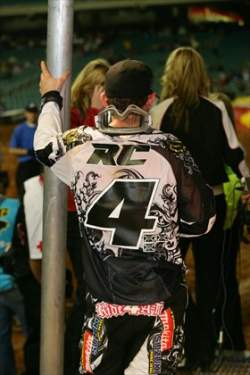Late last night, with the help of Yamaha of Troy’s Dave Osterman,
I was able to track down VP Racing Fuels’ Bruce Hendel. Bruce is the
Global Sales Manager for the company, and he wanted to discuss his
company’s opinion on the fuel penalties that have rocked the sport
three times now—the latest being Ricky Carmichael’s 25-point deduction
following a positive test for lead following the San Diego SX—and ways
that VP hopes to help fix the problems associated with such stringent
fuel rules as the .005 grams per liter currently allowed for AMA
motocross and supercross.
Racer X:
Bruce, I appreciate you taking the time to talk with us. I know you’re
busy getting ready to leave for two weeks at Daytona, but on the
supercross front, it’s obviously been a very busy week for everyone.
Bruce Hendle: Yes it has, Davey. The phone’s been ringing off the hook
a bit, but not quite as much as it did the first two times this issue
came up.
Carmichael’s fuel from San Diego was found to be out of compliance,
and this follows similar incidents in each of the last two years with
Yamaha and Kawasaki. In all three cases, VP Fuels was involved. But
then again, what people might not know is that VP is the provider of
the fuel for not only those three teams, but also KTM and Honda. Is
that correct?
Yes, we provide the fuel for all the factory teams and most of the
factory-support teams in the Lites class—Yamaha of Troy, Pro Circuit,
the SoBe Samsung Honda team, the BooKoo Energy team….
What happened in San Diego must have come as a real shock to VP,
just as it caught Carmichael and the whole sport off guard as well.
Well, it was a surprise to us just as the last couple times were, and
again we’re concerned as much as anyone else is. Obviously, we’ve been
involved in supplying fuel to professional motocross for 25 years, and
we take this pretty seriously. Our track record is pretty exemplary and
we certainly want to work—and we have worked—with any teams that have
had these issues. Of course, these issues never really came up until
the unleaded rule was instituted.
The unleaded rule is a leftover from the AMA/Jam Sports thing, and
.005 grams per liter is a really, incredibly small number, isn’t it?
Well, it’s parts per billion, so that should tell you how small it is.
The thing is, the EPA allows .013 grams per gallon in our pump gas, and
it’s still an unleaded pump gas that’s legal for the street. So that
doesn’t mean you’re going to find .013 in every pump-gas sample that
you check, but potentially it could be .013 and it’s still legal, which
is two-and-a-half times over the legal limit the AMA allows. It was
always our understanding that the AMA rule was in place to allow racers
to use pump gas and not fail.
 | | DeCoster did his best to explain what he felt were problematic lead limits. | |
|
If you really do the science, wouldn’t it actually have the opposite effect, if most pump gas is as leaded as you say?
Well, the pump gas—remember, it’s a small amount of lead, because you
can never get 0.00000; it’s not going to happen. There’s lead that
exists in our society in a lot of different things, so it can never be
truly zero. There’s always going to be some amount that you’re going to
find. I mean, there’s lead just organically found in dirt, and of
course it’s not tetraethyl lead, which is what we use when we’re
putting lead in race fuels to help increase the octane. And that’s
another thing, too—the test that’s done for lead doesn’t determine
whether it’s tetraethyl lead or some other form of lead.
So not all lead is necessarily beneficial. Is it safe to say that no
lead at that amount would alter the performance of a two-stroke or
four-stroke motorcycle?
Well, understand that what lead does is increase octane; it’s an octane
improver. And in order to get a benefit from tetraethyl lead—and again,
it’s a small benefit, a small octane benefit—you would have to have a
tenth to two-tenths of a gram of lead per gallon to begin to start
seeing an advantage in the octane. And leaded race fuel has four grams
of lead per gallon; it’s something like 300 times more than the EPA
limit for the amount of lead allowed in unleaded fuel. So actually,
racing fuel has 300 times more lead than what pump gas is allowed to
have.
I use that example because a big issue is being made
about Suzuki’s fuel being three-and-a-half times over the legal limit,
but three-and-a-half times over almost zero lead is not a lot of lead.
And then remember, racing fuel is 300 times what the EPA allows.
I heard when we spoke to Roger DeCoster on Saturday afternoon, when
he spoke to the media—and this is also something that Ricky said later
on—that more of a benefit would have come from having a higher oxygen
content, but Suzuki was actually way on the low side there. Is that
correct?
Yes. The oxygen test that came back was pretty well under what the AMA
allows for oxygen, and the amount of lead that was in the fuel sample
they tested, even at three-and-a-half times over the legal limit, still
does not increase the performance in any way of that fuel. It would
have been a much bigger increase [in performance] if the oxygen level
was up to the legal limit, but it wasn’t; it was way under the legal
limit.
Which brings us to one other thing, by the way:
Again, going back to pump gas and the original intent of the rule—which
was to allow pump gas to be legal in order to keep the racing
affordable for the racers who wanted to use pump gas—there’s pump gas
in this country that, at certain times of the year and in certain
cities, can have up to 3.7 percent oxygen. The AMA’s limit is 2.8
percent. So again, if a racer was in that city and went to the local
gas station and bought some pump gas, they could end up running illegal
fuel.
I saw Mr. Burns’ release that calls for the AMA to revise its fuel
rules to reflect a more real situation both at the pumps and as far as
what enhances performance and what doesn’t. What would be, in your
personal opinion, a workable level, not only for the gasoline
providers, but a test that would truly even the playing field and be a
measurable amount that would work for everyone?
Well, if they truly want to have a rule that won’t eliminate anybody
from running pump gas in this country, they should raise the oxygen
level to 3.7 percent. The lead level should be raised to at least .013
grams per liter. However, understand that the fuel is handled, in the
environment of racing, a number of times—quite a bit more than what you
put in your passenger car. Regular pump gas is manufactured at a
refinery, goes into a tanker, gets delivered to the station, and comes
out of the pump directly into your car. When we’re racing, the race
fuel obviously has to be delivered in a drum to transport it to the
racetrack. When it gets there, the drum is opened for various reasons,
whether it’s to get a sample and have it tested, whether it has to be
pumped into a transfer can, which then is poured usually through a
funnel into a bike, which is then raced in harsh conditions—dirt and
dust—and at the end of the race weekend the fuel is drained out of the
bike, put back in the can, goes to the next race, and part of that fuel
comes back out, so it’s being handled and transferred a number of
times. It would seem to make sense to have a limit that’s even a little
more tolerant of the additional handling that this fuel goes through.
And I’ve said you could easily make the rule state that you could have
up to a tenth of a gram of lead per gallon and still not have any
performance benefit, and that would allow for incidental contamination
through the handling.
 | | Bruce
Hendle of VP Racing Fuels feels that privateers can barely meet the
FIM/AMA fuel restrictions because pump gas in America is different than
what it is in Europe | |
|
Let
me ask a layman’s question: What material is a petcock made of on a
contemporary MX bike, and is that where they take the fuel from? Also,
do they drain it from the bottom of a fuel hose, or do they take it
right from the top of the gas tank, and could that also come into play?
It’s my understanding that they take it from the petcock, and I believe
those parts are made out of aluminum, but honestly, I don’t know. I
don’t have the details, and different manufacturers use different kinds
of metals—I wouldn’t be able to answer that.
What about—and I’m going with my high-school chemistry here—is there
lead in glass products? Like, let’s say the samples were taken in glass
tubes or at any point came into contact with glass.
Yes, there can be. Not all glass, but it is potentially possible to
have glass that contains lead. As a matter of fact, if you look at the
actual testing standards for collecting samples of fuel to test for
lead—I think it’s an ASTM, an American Standards of Testing
Method—their standards for collection of fuel for doing lead tests do
not spec out glass containers, because of that potential contamination
issue.
Well, I would certainly expect not only the AMA, but also the lab
they use, to make sure that’s the case. But even with all that, there
really doesn’t seem to be any argument that the fuel was over the
limit, but the problem here seems to be that the limit is not a real,
workable limit. This is the third time now that it’s really badly
affected a rider or team that obviously got no benefit from it. Beyond
changing the rule and changing that number, what else can we do so that
in the future we don’t have this kind of controversy or this kind of
misunderstanding or outright violation?
Well, the thing is, they took eight samples [in San Diego], and all
eight samples were VP Racing Fuel. Seven out of eight samples were
fine, and we don’t make this product one drum at a time; we make this
product in large batches. Now, we’re certainly not trying to point the
finger at Suzuki in any way, and like I said, we’re trying to work with
Suzuki to figure out exactly what happened, just like we did with
Yamaha and Kawasaki, and in those two issues there were innocent
handling issues where there was no blatant attempt to try to cheat.
In the case of Kawasaki, it turned out they were
using metal cans that use a lead-base solder on the seams, and that’s
what leached out into the fuel and caused their fuel to be illegal. And
I believe Kawasaki’s samples were actually still under the EPA limit
for unleaded fuel, but over the AMA’s limit. The answer is, if the rule
isn’t going to be changed, then I think the penalty for the infraction
needs to be fixed.
To make a comparison, this is like getting 25 years for jaywalking;
it’s an extremely heavy penalty. Granted, I have a great amount of
respect for Steve Whitelock in sticking to the precedent that had been
set, but that doesn’t necessarily make it right in the first place.
Right. I understand that he’s enforcing the rules and that there was a
precedent, but like you said, if the penalty was to take the guy out
back and shoot him, it doesn’t mean it was right to shoot the first guy
[laughs].
 | | Mechanics
like Mike Gosselaar must worry about how they handle anything that may
come into contact with fuel or risk having the fuel contaminated by
lead | |
|
Let
me get back to something, Bruce. You mentioned the issues with Kawasaki
and Yamaha, and because that Yamaha situation was the first situation
that arose, it was discovered that they had used a can that had been
used before the leaded rules changed, before the series went
all-unleaded in 2004.
With Yamaha, I don’t know exactly what they released to the public, so
I don’t know if I’m at liberty to discuss what the problem was, but
it’s safe to say it was a handling issue after the fuel was removed
from the drum. It was an innocent handling issue where nobody was
trying to get a competitive advantage.
I bring this up because I was standing in the Suzuki pits on
Saturday and talking to Roger, and he was expressing his utter
disbelief that this was all happening, when Mike Gosselaar, Ricky’s
mechanic, came over wearing a pair of plastic gloves and holding the
needle from the carburetor and asked whether they had chemical bio
suits around before he put the carburetor back together. We all got an
uneasy chuckle out of it, but seriously, at the rates of lead we’re
talking about here, it could come from his fingers, couldn’t it?
It’s such a small amount. If you used—and this is something the
privateers need to be aware of—if you’re practicing during the week and
you use a regular, plastic fuel jug and you happen to be running leaded
fuel because it’s a little more affordable, if you come straight to the
race weekend—even if that fuel jug is empty and dry—there’s enough lead
in the pores of the plastic that once you pour unleaded fuel in there,
that fuel is not going to pass. It’s parts per billion and such a small
amount that I don’t actually know what would have to be on your hands
to contaminate it. I don’t know.
If you set a rule in stone, you’re going to have these sort of
difficulties, not only in checking it but in enforcing it, because so
often the punishment doesn’t fit the crime—or rather the, crime doesn’t
fit the punishment. In all three cases, the fuel may have all violated
the rule, but it wasn’t against the spirit of the sport, was it?
No, it wasn’t. The intent of the rule is that they don’t want the
racers to run leaded fuel—that’s the bottom line—and so a limit was
set. But the limit, as we’ve talked about, is too strict, at least for
this country, and the penalty for violating that, especially when
you’re not getting any performance advantage…. Steve Whitelock made the
comment that he did not believe any of these guys were trying to
cheat—I think he believes that now. I think back when the Yamaha
incident happened, I believe somebody thought it was possible somebody
was trying to cheat; it was a brand-new rule and I think somebody
thought, A ha! We caught somebody using leaded fuel!
I have to admit I was personally guilty of that, and the next time I
see Jim Perry of Team Yamaha, I’m going to apologize to him, because it
was a new rule, they were racing a two-stroke, [Kevin] Windham was on a
four-stroke…. But then the whole thing just went away, at least for the
general public, because it didn’t really affect the championship. And
last year with Kawasaki, again, it was a pair of two-strokes against a
whole bunch of four-strokes outdoors, and it didn’t affect the
championship. But now we have a four-stroke that doesn’t benefit as
much as a two-stroke even if it is lead, is that correct?
Well, we know that four-strokes make a lot more power than two-strokes
to begin with, and in order to get the power out of the two-stroke,
typically you have to do things that modify the engine where you need
to have that additional octane, so there’s a benefit there. But the
four-strokes, in general, don’t need a lot of octane. All of our
motocross race fuels are fairly low-octane fuels, they just have a lot
of energy and make a lot more power than what you get out of the gas
pump or typical, standard-type race fuels, whether they’re leaded or
unleaded.
The AMA announced early this evening that they would be launching an
investigation. What do they need to be looking into, and how will VP
try to help them come up with the right system, the right levels, and
the right penalty?
Well, we would love to help them in any way, from our experience in the
industry and supplying these teams for so many years, but what’s
strange is that, really, I believe once in 1996 or 1997 Rob King called
and asked for our opinion on a fuel issue, but that was it. We would
love to be more active in it—we’ve actually tried to be more active in
it. We’ve sent e-mails and letters on any type of fuel issue that we
thought might be a problem or something they should be concerned
about—but the disappointing thing is that we never get a response.
Well, I certainly hope that in light of all these things and where
we stand now as a sport, as a series, I hope that they will reach out
and vice versa, and you can all get together to make some regulations
that work a little better for the situation.
I think we all think the same thing: It’s a shame that a championship
can be decided on an infraction that had no performance advantage, and
that’s really the bottom line. If there’s anything that we can do to
help resolve the situation or help guide the teams or the AMA, we’re
certainly willing to contribute. We’ve been in business for 31 years
now, the owner of our company owns a motocross track [Cycle Ranch in
Texas]…. We love the sport and don’t want to do anything to hurt it.
Well, I appreciate that, and I think it’s a great place to leave our interview. Is there anything else you’d like to add?
Just that I think all the teams believe in VP Racing and what we’re
doing. I know that Yamaha, since they had their issue, has tested, at
their own expense, every drum of fuel we’ve delivered to them since
their incident, and none of them have come back illegal.
Thanks, Bruce, and good luck on the resolution of this issue.
Thank you.






